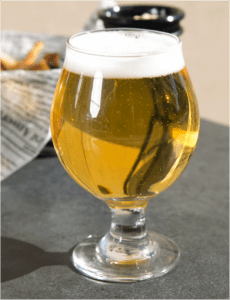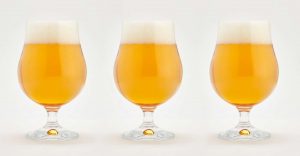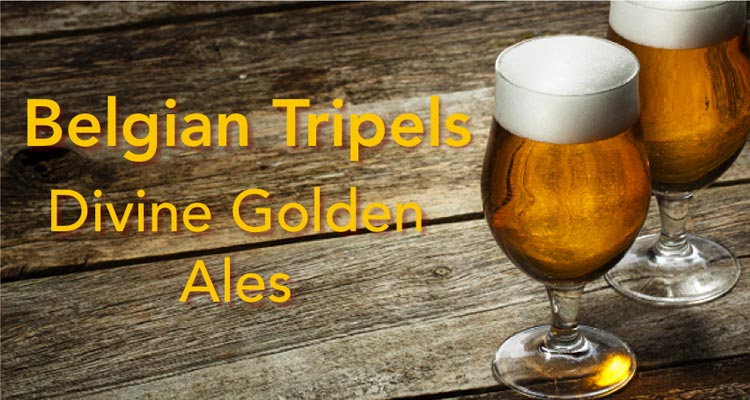Do you know how to properly pronounce “Tripel”? This Belgian-style beer’s name often trips people up. Today, we will teach you to quaff like an expert. Read on to learn the correct pronunciation, and all the details you need to know about this excellent brew.
As a long-time brewer of Belgian-style beers, people often ask me which is my favorite Belgian style. That’s always hard to answer, as I like so many of them. I must say, though, that Tripels are often at the top of the list. If I go into a brewery that brews Belgian styles, their Tripel is often my benchmark for how I evaluate their overall quality. Why? Tripels are challenging to brew and flaws are difficult to hide.
First things first: how to pronounce “Tripel
Something that always drives me crazy is the multitude of ways people pronounce Tripel. The most irksome pronunciation is “treh-Pell” with emphasis on the “P.” The correct way to pronounce it is the way we would say it: “triple.” A Belgian accent may turn that into “tree-pull” but it would never end up “treh-Pell.” As one brewer here in Denver aptly said, “That’s the pronunciation to use if you want to sound like a pretentious ass.”
The History of Tripel

Westmalle Tripel in all its glory!
When Czech brewery Pilsener Urquell introduced its clear golden lager beer in 1842, it started a revolution in European beer. Beers no longer had to be dark and cloudy, or be hidden in pewter or earthenware drinking vessels. Over the decades that followed, clear golden beers began to be served in clear glasses, becoming the rage in Europe. Everyone wanted pilsners. Darker beers – including many of the great traditional beers of Belgium – were waning in popularity. Belgian brewers needed to find a way to compete.
In the early 1930s, brewing scientist and yeast specialist Hendrik Verlinden of the Drie Linden brewery experimented with a golden ale to compete with pilsners and other popular golden lagers. In 1932, he
released Witkap Pater, a Tripel ale. He also helped the Westmalle Trappist brewery develop their Tripel, which they had been working on for some time.
In these days, it was common for Trappist breweries to name their beers based the designations enkel (single), dubbel and tripel – corresponding to the relative amount of malt used and often to 3, 6 and 9 percent alcohol. All three strengths would have been darker beers. When Westmalle released its first Tripel in 1934, it was a strong golden ale, and proved to be a real game-changer. In 1956, Westmalle changed the recipe slightly to include more hops, and it has remained unchanged since then. To this day, many consider Westmalle Tripel to be the standard by which all other Tripels are measured.
The Tripel Style

Delicious Tripel in a glass.
Tripels are strong beers that are bright yellow to deep golden in color, with a big, dense, creamy ivory head. They have a fruity and complex aroma, spicy phenolic, and distinct Belgian yeast character. They are malty and evenly balanced with hops and alcohol. Tripels get their rich maltiness from a high percentage (even as high as 100%) of Belgian pilsner malt, with a small percentage of specialty malts, such as aromatic and light crystal. Some Tripels – like Tripel Karmeliet – add small portions of wheat and oats as well. Tripels also include up to 20 percent Belgian candi (beet) sugar to lighten its body and produce a dry finish. Typically in the 8-11% alcohol range, they have a complex, rich, sweet, malty flavor that finishes dry and clean.
Tripels are hoppy with a substantial bitterness – up to 40 IBUs. The hops and the malt are generally in balance with additional bitterness provided by the alcohol, which tends to stay well-hidden. Hops are typically floral and herbal varieties from Germany, France, the Czech Republic, and Slovenia. Belgian yeast characterizes tripels with spicy phenols (clove, nutmeg, pepper and cinnamon) and fruity esters (banana, apple, pear, apricot). Some brewers also add small amounts of real spices to their brew kettles for added depth of complexity. Most Belgian tripels are bottle conditioned (naturally carbonated in the bottle), which produces a soft texture, gentle carbonation, big pillowy head, and added complexity.
Variations

Three Tripels. Mmmm
At Bruz Beers, we make a variety of Tripels. One of our favorites is Talus Tripel, with barley, wheat, oats, and a light touch of orange peel and coriander. We also make Three Peaks Tripel – a classic Trappist-style tripel – and Trident, which uses two different Pilsner malts and an exotic array of hops. Because Tripels provides a good base for other ingredients, I have had interesting Tripels from home brewers and craft brewers that incorporate fruits, spices, barrel-aging, specialty malts, and non-traditional hops.
Whatever variations suit your taste, Tripels are majestic beers. Both simple and complex, with high
alcohol and restrained intensity, Tripels are truly divine!
To try Tripels and other Belgian-style beers from Bruz Beers and other craft brewers, come to the Belgian Brew Fest on Saturday, April 28th. Click here for more information and tickets. See you there!




Leave a Reply